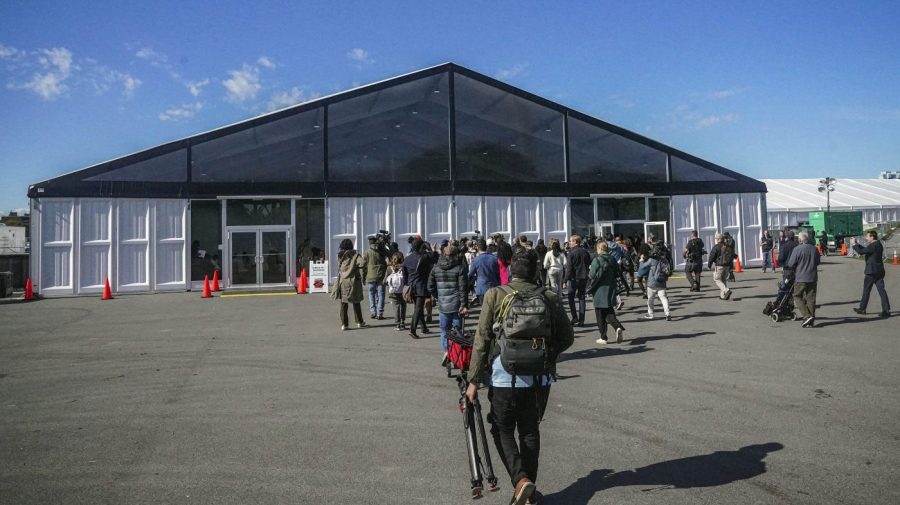World News
Biden’s punt to Congress on immigration is wearing thin with advocates on September 11, 2023 at 11:47 am

Immigration advocates are growing weary of the Biden administration’s measured use of executive power to grant work papers to immigrants.
Over three years, Team Biden has systematically drawn back the Trump administration’s efforts to shrink programs such as Temporary Protected Status (TPS), but at a deliberate pace that’s irked immigrant communities.
Further fueling frustration is the administration’s fall-back position that immigration woes are the result of congressional inaction.
“So this line about waiting for Congress – we cannot wait. That ship has sailed. The only relief that can be offered to the immigrant community now is through the administration,” said Jossie Flor Sapunar, national communications director for advocacy group CASA.
Comprehensive immigration reform has evaded Congress for decades, and it remains one of the most divisive issues in U.S. politics.
As the Biden administration’s repeated finger-pointing at Congress gnaws at advocates, Democrats warn of the dangers of a divided immigrant advocacy community.
“I think everybody has skin in the game. I think there’s a level of responsibility from Congress, from the executive, from localities, from states,” said Rep. Adriano Espaillat (D-N.Y.), who’s often butted heads with his party over immigration.
“It’s not one person [who’s] fully responsible. I think we all have to work together on this. We can’t go at each other because this is not gonna be resolved if we do it that way.”
Yet the administration has a number of unused arrows in its quiver.
Groups such as CASA, which boasts more than 100,000 members across 46 states, say that TPS is the most powerful tool in the president’s executive arsenal.
TPS is designed to protect nationals of a country in crisis from forcible repatriation. Nationals of a designated country who are present in the United States are allowed to live and work legally while the designation is active.
A CASA-led coalition of more than 350 entities ranging from civil rights groups to immigrant advocates and major labor unions on Monday called on Homeland Security Secretary Alejandro Mayorkas to redesignate El Salvador, Honduras, Nicaragua and Nepal for TPS.
The groups separately asked Mayorkas to also redesignate Guatemala and Venezuela.
A redesignation would massively expand the number of people covered by the program.
“A decision to redesignate TPS for these countries would of course be life-changing for those who have made their lives here,” wrote the groups.
“In addition, a wealth of research demonstrates the benefits to all workers and the economy of granting legal status to persons who already live and work in the U.S. and specifically documents the huge economic contributions of persons who have or would be eligible for TPS.”
When a designation is due to expire, the Homeland Security secretary can either issue a renewal, extending TPS protections for existing beneficiaries, or a redesignation, extending those protections to all nationals of the designated country who are physically present in the United States.
El Salvador, Honduras, Nicaragua and Nepal, known collectively as the Ramos countries after a TPS-related lawsuit against the Trump administration, had their TPS designations renewed by the Biden administration in June.
The Trump administration had attempted to terminate TPS designations for those countries, but was stymied by the courts in the Ramos case.
Upon Biden’s election, advocates expected the Department of Justice to swiftly withdraw from that lawsuit and the Department of Homeland Security to rescind Trump’s terminations.
Those rescissions came in June, paired with the renewals.
But they also came with a bundle of confusing red tape, where Ramos TPS holders were given 60 days to renew their individual status, though the country designations were extended to 2025.
On Friday, advocates scored a major win when the Biden administration extended the registration period for Ramos countries from 60 days to 18 months, after pressure from civil rights organizations and the Congressional Hispanic Caucus.
But those wins seem to come at a snail’s pace, and advocates are uneasy that the Biden administration has not shown the same zeal for immigrant relief that the Trump administration showed for cracking down.
For instance, advocates on the outside routinely present the Biden administration with ideas to get maximum mileage out of existing legislation, while the previous administration made it a priority to have restrictionist advocates in-house, actively looking for ways to deter or minimize immigration.
A coalition of 24 advocacy groups, including top Hispanic political, business and civil rights groups, called on Attorney General Merrick Garland and Mayorkas to make use of two relatively obscure immigration provisions to help mixed-status families get papers for their relatives.
“The undersigned organizations have long advocated removing the barriers immigrant families face because it is critical to creating a fair and just nation where everyone’s contributions are equally valued and appreciated,” the groups wrote in an Aug. 24 letter.
“Given the current challenges of advancing comprehensive immigration reform in this divided Congress, we firmly believe that there are administrative measures that can be taken in the interim to provide essential relief to our community.”
One proposal involves cutting down a backlog of visa or green card applications for people who are legally eligible but need to get a waiver for having accrued unlawful presence in the United States. The groups also asked for people in that situation to receive temporary work permits.
The other involves undocumented people who have been in the United States for more than 10 years, have family in the country, have “good moral character” and have not committed crimes, and whose departure would signify hardship for their families.
People in that group are eligible to apply for permanent residency but must first be facing removal in immigration court.
“Paradoxically, the very facts that could make certain long-time undocumented residents strong candidates for relief under cancellation of removal – typically that they are low enforcement priorities – often prevent them from accessing this powerful form of relief which requires that applicants first be in removal proceedings,” wrote the groups.
The Biden administration regularly fields proposals of the sort from advocates and Democrats in every level of government, as well as business, religious and civil rights institutions.
And even as patience grows thin, advocates admit what they’re asking of the Biden administration is only a small step toward their goal.
“So the reality is TPS is not the end game. The North Star is always citizenship,” said Sapunar.
“And yes, that is in the hands of Congress to do. But Congress failed. And again, this program is now the relief that the president can offer. That is the best we can do considering the political scenario. So no, we don’t want TPS for the long term. The goal is always citizenship for 11 million people.”
Immigration advocates are growing weary of the Biden administration’s measured use of executive power to grant work papers to immigrants. Over three years, Team Biden has systematically drawn back the Trump administration’s efforts to shrink programs such as Temporary Protected Status (TPS), but at a deliberate pace that’s irked immigrant communities. Further fueling frustration is…
News
US May Completely Cut Income Tax Due to Tariff Revenue

President Donald Trump says the United States might one day get rid of federal income tax because of money the government collects from tariffs on imported goods. Tariffs are extra taxes the U.S. puts on products that come from other countries.

What Trump Is Saying
Trump has said that tariff money could become so large that it might allow the government to cut income taxes “almost completely.” He has also talked about possibly phasing out income tax over the next few years if tariff money keeps going up.
How Taxes Work Now
Right now, the federal government gets much more money from income taxes than from tariffs. Income taxes bring in trillions of dollars each year, while tariffs bring in only a small part of that total. Because of this gap, experts say tariffs would need to grow by many times to replace income tax money.
Questions From Experts
Many economists and tax experts doubt that tariffs alone could pay for the whole federal budget. They warn that very high tariffs could make many imported goods more expensive for shoppers in the United States. This could hit lower- and middle‑income families hardest, because they spend a big share of their money on everyday items.
What Congress Must Do
The president can change some tariffs, but only Congress can change or end the federal income tax. That means any real plan to remove income tax would need new laws passed by both the House of Representatives and the Senate. So far, there is no detailed law or full budget plan on this idea.

What It Means Right Now
For now, Trump’s comments are a proposal, not a change in the law. People and businesses still have to pay federal income tax under the current rules. The debate over using tariffs instead of income taxes is likely to continue among lawmakers, experts, and voters.
News
Epstein Files to Be Declassified After Trump Order

Former President Donald Trump has signed an executive order directing federal agencies to declassify all government files related to Jeffrey Epstein, the disgraced financier whose death in 2019 continues to fuel controversy and speculation.
The order, signed Wednesday at Trump’s Mar-a-Lago estate, instructs the FBI, Department of Justice, and intelligence agencies to release documents detailing Epstein’s network, finances, and alleged connections to high-profile figures. Trump described the move as “a step toward transparency and public trust,” promising that no names would be shielded from scrutiny.
“This information belongs to the American people,” Trump said in a televised statement. “For too long, powerful interests have tried to bury the truth. That ends now.”
U.S. intelligence officials confirmed that preparations for the release are already underway. According to sources familiar with the process, the first batch of documents is expected to be made public within the next 30 days, with additional releases scheduled over several months.
Reactions poured in across the political spectrum. Supporters praised the decision as a bold act of accountability, while critics alleged it was politically motivated, timed to draw attention during a volatile election season. Civil rights advocates, meanwhile, emphasized caution, warning that some records could expose private victims or ongoing legal matters.
The Epstein case, which implicated figures in politics, business, and entertainment, remains one of the most talked-about scandals of the past decade. Epstein’s connections to influential individuals—including politicians, royals, and executives—have long sparked speculation about the extent of his operations and who may have been involved.

Former federal prosecutor Lauren Fields said the release could mark a turning point in public discourse surrounding government transparency. “Regardless of political stance, this declassification has the potential to reshape how Americans view power and accountability,” Fields noted.
Officials say redactions may still occur to protect sensitive intelligence or personal information, but the intent is a near-complete disclosure. For years, critics of the government’s handling of Epstein’s case have accused agencies of concealing evidence or shielding elites from exposure. Trump’s order promises to change that narrative.
As anticipation builds, journalists, legal analysts, and online commentators are preparing for what could be one of the most consequential information releases in recent history.
Politics
Netanyahu’s UN Speech Triggers Diplomatic Walkouts and Mass Protests

What Happened at the United Nations
On Friday, Israeli Prime Minister Benjamin Netanyahu addressed the United Nations General Assembly in New York City, defending Israel’s ongoing military operations in Gaza. As he spoke, more than 100 delegates from over 50 countries stood up and left the chamber—a rare and significant diplomatic walkout. Outside the UN, thousands of protesters gathered to voice opposition to Netanyahu’s policies and call for accountability, including some who labeled him a war criminal. The protest included activists from Palestinian and Jewish groups, along with international allies.

Why Did Delegates and Protesters Walk Out?
The walkouts and protests were a response to Israel’s continued offensive in Gaza, which has resulted in widespread destruction and a significant humanitarian crisis. Many countries and individuals have accused Israel of excessive use of force, and some international prosecutors have suggested Netanyahu should face investigation by the International Criminal Court for war crimes, including claims that starvation was used as a weapon against civilians. At the same time, a record number of nations—over 150—recently recognized the State of Palestine, leaving the United States as the only permanent UN Security Council member not to join them.
International Reaction and Significance
The diplomatic walkouts and street protests demonstrate increasing global concern over the situation in Gaza and growing support for Palestinian statehood. Several world leaders, including Colombia’s President Gustavo Petro, showed visible solidarity with protesters. Petro called for international intervention and, controversially, for US troops not to follow orders he viewed as supporting ongoing conflict. The US later revoked Petro’s visa over his role in the protests, which he argued was evidence of a declining respect for international law.

Why Is This News Important?
The Gaza conflict is one of the world’s most contentious and closely-watched issues. It has drawn strong feelings and differing opinions from governments, activists, and ordinary people worldwide. The United Nations, as an international organization focused on peace and human rights, is a key arena for these debates. The events surrounding Netanyahu’s speech show that many nations and voices are urging new action—from recognition of Palestinian rights to calls for sanctions against Israel—while discussion and disagreement over the best path forward continue.
This episode at the UN highlights how international diplomacy, public protests, and official policy are all intersecting in real time as the search for solutions to the Israeli-Palestinian conflict remains urgent and unresolved.

 Entertainment5 days ago
Entertainment5 days agoWicked Sequel Disappoints Fans: Audience Verdict on For Good

 Entertainment3 weeks ago
Entertainment3 weeks agoAfter Party: Festival Winner for Best Romantic Short

 News3 weeks ago
News3 weeks agoCamp Wackapoo – Rise of Glog Takes Center Stage

 News2 weeks ago
News2 weeks agoYolanda Adams Questions Traditional Views on God’s Gender, Audience Reacts

 Entertainment3 weeks ago
Entertainment3 weeks agoFrancisco Ramos Takes Top Mockumentary Award at Houston Comedy Film Festival

 Politics3 weeks ago
Politics3 weeks agoTrump’s $2,000 Tariff Dividend Plan: Who Gets Paid?

 Politics4 weeks ago
Politics4 weeks agoMamdani’s Victory Triggers Nationwide Concern Over New York’s Future

 Film Production3 weeks ago
Film Production3 weeks agoWhy China’s 2-Minute Micro Dramas Are Poised To Take Over The U.S.



























